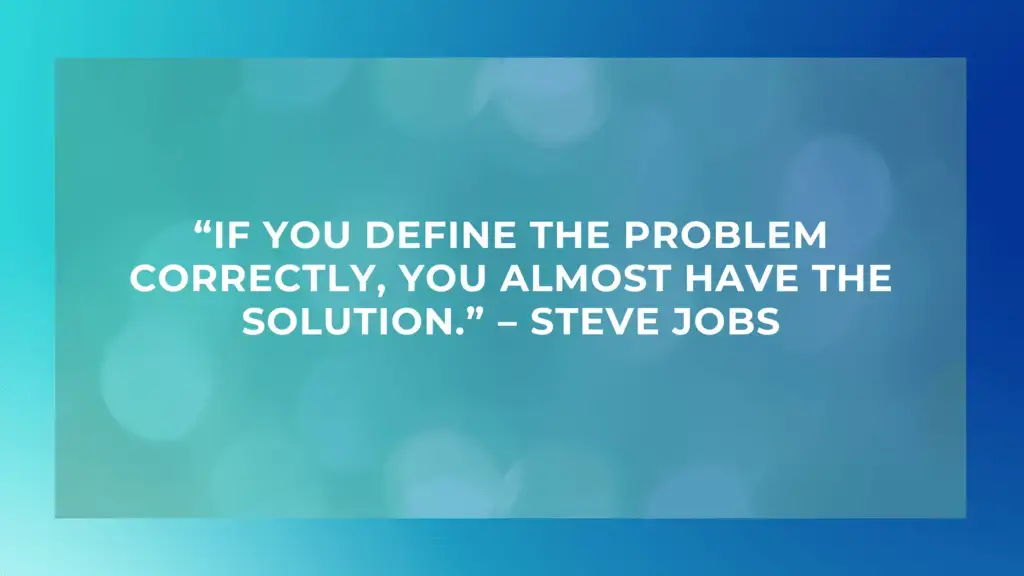Introduction
The problem definition process is a critical skill that can determine the success or failure of an organisation.
However, before diving into solutions, it’s essential to start with a clear and precise definition of the problem at hand.
This foundational step is often overlooked, leading to misguided efforts and wasted resources.
Importance of Problem Definition in Problem-Solving
A well-defined problem is like a roadmap for your problem-solving journey.
It guides you toward relevant solutions, ensuring that your efforts are focused and effective.
Without a clear understanding of what you are trying to solve, you risk addressing symptoms rather than the root cause, leading to temporary fixes instead of lasting solutions.
Proper problem definition not only saves time and resources but also fosters a structured approach that enhances decision-making and innovation.
Overview of the Problem Definition Process
The problem definition process is a systematic approach that helps you articulate the core issue clearly and comprehensively.
This process involves several key steps, including identifying the problem, understanding its context, and framing it in a way that sets the stage for effective solutions.
By following a structured problem definition process, you can ensure that all stakeholders have a shared understanding of the issue, which is crucial for collaborative problem-solving and successful implementation of solutions.
In this blog, we will delve into the critical steps of the problem definition process, explore its benefits, and provide practical tips to help you master this essential skill.
Whether you’re tackling business challenges, organisational issues, or personal dilemmas, learning how to define problems accurately will empower you to find more effective and sustainable solutions.
Understanding the Problem
Effectively solving a problem starts with a deep understanding of the issue at hand.
This involves a few critical steps that ensure you’re not only identifying the right problem but also setting the stage for finding the most impactful solutions.
Identifying the Need for Problem-Solving
The first step in understanding the problem is recognising when there is a need for problem-solving. This often involves:
Recognising Symptoms: Noticing signs that indicate something is wrong, such as declining sales, customer complaints, or operational inefficiencies.
Determining Urgency: Assessing whether the problem requires immediate attention or if it can be addressed over time.
Evaluating Impact: Understanding how the problem affects different areas of the business, including operations, finances, and customer satisfaction.
By accurately identifying the need for problem-solving, you ensure that your efforts are directed toward issues that truly matter.
Defining the Scope and Boundaries of the Problem
Once the need for problem-solving is identified, it’s crucial to define the scope and boundaries of the problem. This involves:
Clarifying the Problem Statement: Articulate the problem in a clear, concise manner. For example, instead of saying “Sales are low,” say “Sales have declined by 20% in the last quarter due to increased competition.”
Setting Boundaries: Determine what is and isn’t included in the problem. This helps to avoid scope creep and keeps the focus on the core issue.
Identifying Stakeholders: Recognise who is affected by the problem and who needs to be involved in the problem-solving process.
Defining the scope and boundaries ensures that everyone has a shared understanding of the problem, which is essential for collaborative problem-solving.
Gathering Relevant Information and Data
With a well-defined problem, the next step is to gather all relevant information and data. This includes:
Collecting Quantitative Data: Gathering measurable data such as financial reports, sales figures, and performance metrics.
Gathering Qualitative Data: Obtaining insights through interviews, surveys, and observations to understand the problem from different perspectives.
Analysing Trends and Patterns: Looking for trends and patterns in the data that can provide deeper insights into the problem’s root causes.
Thorough data collection helps in forming a complete picture of the problem, which is crucial for developing effective solutions.
Describing the Financial Consequences of the Problem
Understanding the financial consequences of the problem is vital for prioritising and justifying the problem-solving efforts. This involves:
Calculating Direct Costs: Identifying immediate costs related to the problem, such as lost sales, increased expenses, or wasted resources.
Estimating Indirect Costs: Considering longer-term financial impacts, such as damage to brand reputation, customer churn, or decreased employee morale.
Evaluating Opportunity Costs: Assessing the potential revenue or growth opportunities lost due to the problem.
Describing the financial consequences provides a compelling case for addressing the problem and helps in securing necessary resources and support from stakeholders.
By thoroughly understanding the problem through these steps, you lay a strong foundation for finding effective, sustainable solutions.
This process ensures that you are addressing the right issues, with a clear understanding of their scope and impact, backed by relevant data and insights.
Analysing the Situation
After understanding the problem, the next crucial step is to analyse the situation in depth.
This involves assessing the current state, identifying key stakeholders, and exploring the underlying causes and potential challenges.
These steps help in gaining a comprehensive view of the problem and laying the groundwork for effective solutions.
Assessing the Current State and Impact of the Problem
To effectively analyse the situation, it’s important to have a clear picture of the current state and the impact of the problem. This involves:
Detailed Assessment: Conducting a thorough review of the current processes, systems, and operations affected by the problem.
This includes identifying specific areas where the problem manifests and evaluating their condition.
Measuring Impact: Quantifying the problem’s impact on various aspects of the business.
This can include metrics such as reduced productivity, lower customer satisfaction, financial losses, or decreased employee morale.
Comparative Analysis: Comparing the current state with desired outcomes or industry benchmarks to highlight gaps and areas needing improvement.
By assessing the current state and impact, you can better understand the magnitude of the problem and prioritise areas that require immediate attention.
Identifying Key Stakeholders and Their Perspectives
Understanding the perspectives of those involved or affected by the problem is essential for a holistic analysis. This involves:
Stakeholder Identification: Listing all individuals or groups who have a stake in the problem and its resolution.
This can include employees, customers, suppliers, investors, and regulatory bodies.
Gathering Perspectives: Engaging with stakeholders to understand their views, concerns, and suggestions regarding the problem.
This can be done through interviews, surveys, focus groups, or informal conversations.
Analysing Stakeholder Interests: Assessing the interests and influence of each stakeholder to understand how the problem affects them and what they hope to achieve through its resolution.
Identifying and understanding stakeholder perspectives ensures that the problem-solving process considers diverse viewpoints and addresses the needs of all parties involved.
Exploring Underlying Causes and Potential Challenges
To develop effective solutions, it’s crucial to go beyond surface symptoms and explore the underlying causes and potential challenges. This involves:
Root Cause Analysis: Using techniques like the 5 Whys, Fishbone Diagram, or Pareto Analysis to identify the fundamental causes of the problem.
Understanding the root causes helps in addressing the core issues rather than just alleviating symptoms.
Identifying Contributing Factors: Recognising secondary factors that contribute to the problem, such as organisational culture, communication gaps, or external market conditions.
Anticipating Challenges: Foreseeing potential obstacles and challenges that may arise during the problem-solving process. This includes resistance to change, resource constraints, or technical limitations.
By exploring underlying causes and potential challenges, you can develop more targeted and sustainable solutions that address the problem at its core and prepare for any difficulties that may arise during implementation.
In summary, analysing the situation involves a comprehensive assessment of the current state and impact of the problem, understanding stakeholder perspectives, and delving into the underlying causes and challenges.
This thorough analysis provides a solid foundation for developing effective and sustainable solutions.
Setting Objectives and Goals
Setting clear objectives and measurable goals is a critical step in the problem-solving process.
This ensures that efforts are focused, progress is trackable, and outcomes are aligned with organisational priorities.
Establishing Clear Objectives for Problem Resolution
The first step in setting objectives and goals is to establish clear objectives for resolving the problem. This involves:
Specificity: Clearly defining what needs to be achieved to resolve the problem. Objectives should be specific and unambiguous to provide clear direction.
Relevance: Ensuring that the objectives are directly related to addressing the identified problem. This helps in focusing efforts on the most critical issues.
Achievability: Setting realistic and attainable objectives that consider the available resources and constraints.
For example, if the problem is declining customer satisfaction, a clear objective could be: “Improve customer satisfaction scores by addressing the top three areas of concern identified in customer feedback.”
Defining Measurable Goals to Track Progress
Once clear objectives are established, the next step is to define measurable goals to track progress. This involves:
Quantifiable Metrics: Identifying specific metrics that can be measured to track progress toward each objective. These metrics should be quantifiable and objective.
Timeframes: Setting clear deadlines or timeframes for achieving each goal. This helps in maintaining momentum and providing a sense of urgency.
Milestones: Breaking down larger objectives into smaller, manageable milestones. This allows for regular progress checks and adjustments as needed.
For example, if the objective is to improve customer satisfaction scores, measurable goals could include: “Increase Net Promoter Score (NPS) by 10 points within six months” or “Reduce average response time to customer inquiries by 50% within three months.”
Aligning Objectives and Goals with Organisational Priorities
To ensure that the problem-solving efforts contribute to the overall success of the organisation, it’s crucial to align objectives and goals with organisational priorities. This involves:
Strategic Alignment: Ensuring that the objectives and goals support the broader strategic goals of the organisation. This helps in securing buy-in from leadership and aligning resources.
Resource Allocation: Allocating resources, such as budget, personnel, and technology, in a way that supports the achievement of the objectives and goals. This ensures that the necessary support is in place.
Communication: Clearly communicating the objectives and goals to all stakeholders to ensure understanding and alignment. This helps in fostering collaboration and accountability.
For example, if an organisational priority is to enhance customer experience, aligning the objective of improving customer satisfaction scores with this priority ensures that efforts are focused on what matters most to the organisation.
In summary, setting objectives and goals involves establishing clear objectives for problem resolution, defining measurable goals to track progress, and aligning these objectives and goals with organisational priorities.
This structured approach ensures that problem-solving efforts are focused, trackable, and aligned with the overall strategic direction of the organisation.
Generating Solutions
Generating solutions is a creative and analytical phase in the problem-solving process where potential answers to the identified problem are developed, evaluated, and prioritised.
This ensures that the chosen solutions are both practical and effective.
Brainstorming Potential Solutions to Address the Problem
The first step in generating solutions is brainstorming. This involves:
Encouraging Creativity: Fostering an open and creative environment where team members feel free to suggest ideas without fear of criticism.
Techniques such as mind mapping, free writing, and role-playing can stimulate creativity.
Diverse Perspectives: Involving a diverse group of stakeholders to bring different perspectives and expertise. This can lead to more innovative and fully thought out solutions.
Quantity Over Quality: Initially focusing on generating as many ideas as possible without evaluating them. This helps in exploring a wide range of possibilities.
For example, if the problem is low employee engagement, a brainstorming session might generate ideas such as implementing flexible work hours, offering professional development opportunities, improving workplace culture, or introducing employee recognition programs.
Evaluating the Feasibility and Effectiveness of Each Solution
After brainstorming, the next step is to evaluate the feasibility and effectiveness of each potential solution. This involves:
Feasibility Analysis: Assessing whether each solution is realistic given the available resources, time, and constraints. Considerations include budget, technology, expertise, and potential risks.
Effectiveness Assessment: Evaluating how well each solution addresses the root cause of the problem and meets the established objectives.
This might involve pilot testing, simulations, or consulting with experts.
Criteria-Based Evaluation: Developing criteria for evaluation, such as cost, time to implement, expected benefits, and alignment with organisational goals.
Using a scoring system or decision matrix can help quantify the evaluations.
For example, in addressing low employee engagement, solutions like flexible work hours might be highly feasible and effective, while implementing a comprehensive employee development program might require more resources and time.
Prioritising Solutions Based on Their Potential Impact and Resource Requirements
Once potential solutions have been evaluated, they need to be prioritised based on their potential impact and the resources required for implementation. This involves:
Impact Analysis: Estimating the potential positive outcomes and benefits of each solution. This includes immediate and long-term effects on the problem and overall organisational performance.
Resource Assessment: Considering the resources required for each solution, including financial costs, human resources, time, and technological needs.
Cost-Benefit Analysis: Comparing the expected benefits of each solution against the costs and resources needed.
This helps in identifying high-impact, cost-effective solutions.
Prioritisation Matrix: Using tools like a prioritisation matrix to rank solutions based on impact and feasibility. This helps in making informed decisions and focusing efforts on the most promising solutions.
For example, solutions to low employee engagement might be prioritised with a focus on those that offer significant improvements with manageable resource requirements, such as introducing flexible work hours first, followed by more resource-intensive initiatives like employee development programs.
In summary, generating solutions involves brainstorming potential ideas, evaluating their feasibility and effectiveness, and prioritising them based on their potential impact and resource requirements.
This structured approach ensures that the chosen solutions are practical, effective, and aligned with organisational capabilities and goals.
Selecting the Best Solution in the Problem Definition Process
After generating and evaluating potential solutions, the next step is to select the best one. This involves a thorough analysis of each solution, considering various factors, and choosing the one that aligns best with the defined objectives and goals.
Conducting a Thorough Analysis of Each Solution
To ensure that the best solution is selected, it is essential to conduct a detailed analysis of each potential solution. This includes:
In-Depth Evaluation: Reassessing each solution in detail, considering all aspects of feasibility, effectiveness, and alignment with objectives.
This might involve conducting pilot tests, running simulations, or seeking expert opinions.
Scenario Analysis: Exploring different scenarios for each solution to understand potential outcomes and impacts. This helps in anticipating challenges and opportunities.
Stakeholder Feedback: Gathering input from key stakeholders to ensure that their insights and concerns are considered.
This ensures that the chosen solution has broad support and is practical from various perspectives.
For example, in solving a problem of low employee engagement, an in-depth evaluation might involve running a small-scale pilot of a flexible work hours program to gather data on its effectiveness and feasibility.
Considering Factors Such as Cost, Time, and Risk
When analysing potential solutions, it’s crucial to consider factors such as cost, time, and risk. This involves:
Cost Analysis: Estimating the total costs associated with each solution, including initial investment, ongoing expenses, and potential cost savings.
A detailed cost-benefit analysis can help quantify the financial implications.
Time Considerations: Assessing the time required to implement each solution and achieve desired results. Solutions that deliver quick wins might be prioritised if immediate results are needed.
Risk Assessment: Identifying potential risks associated with each solution and evaluating their likelihood and impact.
This includes considering technical risks, operational risks, and resistance to change.
For example, in addressing low employee engagement, offering flexible work hours might have low implementation costs and minimal risks compared to a comprehensive employee development program, which could be more costly and complex.
Choosing the Solution That Best Meets the Defined Objectives and Goals
The final step is to choose the solution that best meets the defined objectives and goals. This involves:
Alignment with Objectives: Ensuring that the selected solution directly addresses the root cause of the problem and aligns with the specific objectives set earlier. The solution should contribute to achieving the desired outcomes effectively.
Balancing Trade-Offs: Considering the trade-offs between different factors such as cost, time, impact, and risk. The selected solution should offer the best balance, delivering the maximum benefit with manageable costs and risks.
Decision-Making Tools: Utilising decision-making tools such as decision matrices or weighted scoring models to systematically compare solutions and make an informed choice.
For example, if the objective is to quickly improve employee engagement with minimal cost, the flexible work hours solution might be selected over a more resource-intensive employee development program, even if the latter offers more comprehensive benefits in the long term.
In summary, selecting the best solution involves conducting a thorough analysis of each option, considering factors like cost, time, and risk, and choosing the solution that best meets the defined objectives and goals.
This structured approach ensures that the chosen solution is practical, effective, and aligned with the organisation’s capabilities and strategic priorities.
Implementing the Solution
Once the best solution is selected, the next critical phase is its implementation.
This involves developing a detailed action plan, assigning responsibilities, allocating resources, and monitoring progress to ensure the solution is effectively put into practice and achieves the desired outcomes.
Developing an Action Plan for Implementation
An action plan is a roadmap that outlines the steps required to implement the solution. This involves:
Defining Tasks and Activities: Breaking down the solution into specific tasks and activities that need to be completed.
This helps in organising the implementation process and ensuring all necessary steps are included.
Establishing Timelines: Setting clear timelines and deadlines for each task. This ensures that the implementation stays on track and that progress can be monitored.
Setting Milestones: Identifying key milestones and deliverables that mark significant points in the implementation process.
This helps in tracking progress and celebrating achievements along the way.
For example, if implementing a flexible work hours program to improve employee engagement, the action plan might include tasks such as drafting a new policy, conducting training sessions, and setting up a feedback system, with specific deadlines for each.
Assigning Responsibilities and Allocating Resources
Successful implementation requires clear assignment of responsibilities and efficient allocation of resources. This involves:
Assigning Roles and Responsibilities: Clearly defining who is responsible for each task and activity.
This includes assigning project leaders, team members, and other stakeholders involved in the implementation.
Allocating Resources: Ensuring that the necessary resources, such as budget, personnel, technology, and materials, are available and allocated appropriately.
This helps in avoiding bottlenecks and ensuring smooth execution.
Providing Training and Support: Offering training and support to those involved in the implementation to ensure they have the skills and knowledge needed to perform their roles effectively.
For instance, for the flexible work hours program, responsibilities might be assigned to HR for policy development, managers for overseeing implementation within teams, and IT for setting up necessary systems, with appropriate resources allocated to each.
Monitoring Progress and Making Adjustments as Needed
Continuous monitoring and flexibility are key to successful implementation. This involves:
Tracking Progress: Regularly tracking the progress of the implementation against the action plan. This includes monitoring task completion, timelines, and milestones.
Evaluating Performance: Assessing the performance of the implementation by collecting data and feedback. This helps in understanding how well the solution is working and identifying any issues.
Making Adjustments: Being prepared to make adjustments and improvements based on the feedback and data collected.
This ensures that any problems are addressed promptly and that the solution remains effective.
For example, in implementing the flexible work hours program, regular check-ins with employees and managers can help track progress, while surveys and feedback sessions can provide insights into the program’s effectiveness and areas for improvement.
In summary, implementing the solution involves developing a comprehensive action plan, assigning responsibilities and allocating resources, and continuously monitoring progress to make necessary adjustments.
This structured approach ensures that the solution is effectively executed and achieves the desired outcomes, contributing to the overall success of the problem-solving effort.
Evaluating Results
Evaluating the results of an implemented solution is a crucial step in the problem-solving process. This involves assessing the effectiveness of the solution, comparing outcomes with initial objectives and goals, and identifying lessons learned and areas for improvement.
Assessing the Effectiveness of the Implemented Solution
The first step in evaluating results is to assess how effectively the implemented solution addressed the problem. This involves:
Data Collection: Gathering quantitative and qualitative data related to the solution’s performance. This might include metrics such as sales figures, customer satisfaction scores, productivity rates, and feedback from stakeholders.
Performance Analysis: Analysing the collected data to determine whether the solution has met the expected standards.
This includes identifying any deviations from expected outcomes and understanding the reasons behind them.
Stakeholder Feedback: Soliciting feedback from stakeholders involved in or affected by the solution.
Their insights can provide valuable information on the solution’s practical impact and any unforeseen issues.
For example, if the solution was a flexible work hours program, effectiveness might be assessed through employee engagement surveys, productivity metrics, and feedback from both employees and managers.
Comparing Outcomes with Initial Objectives and Goals
Once the effectiveness is assessed, it’s important to compare the actual outcomes with the initial objectives and goals set during the problem-solving process. This involves:
Objective Comparison: Reviewing the specific objectives and goals defined earlier and comparing them with the results achieved.
This helps in determining the extent to which the solution met its intended targets.
Gap Analysis: Identifying any gaps between the desired outcomes and the actual results. Understanding these gaps helps in recognising areas where the solution may have fallen short.
Success Metrics: Evaluating key success metrics to understand the overall impact.
This includes both quantitative measures (e.g., percentage increase in customer satisfaction) and qualitative measures (e.g., improvements in employee morale).
For instance, if the initial goal was to increase employee engagement by 20% within six months, the actual engagement levels post-implementation would be compared to this target to assess success.
Identifying Lessons Learned and Areas for Improvement
The final step in evaluating results is to identify lessons learned and areas for improvement. This involves:
Reflective Analysis: Reflecting on the entire problem-solving process to identify what worked well and what didn’t.
This includes considering both the implementation and the outcomes.
Documenting Insights: Documenting lessons learned, including successful strategies, encountered challenges, and how they were addressed.
This information is valuable for future problem-solving efforts.
Continuous Improvement: Identifying specific areas where improvements can be made.
This might involve tweaking the current solution, enhancing processes, or addressing any shortcomings revealed during the evaluation.
For example, if the flexible work hours program led to increased employee engagement but also highlighted issues with team coordination, this insight would be documented, and strategies to improve team collaboration would be developed.
In summary, evaluating results involves assessing the effectiveness of the implemented solution, comparing outcomes with initial objectives and goals, and identifying lessons learned and areas for improvement.
This thorough evaluation ensures that the problem-solving process is continuously refined and that future efforts are more effective and efficient.
Conclusion
In navigating the complexities of problem-solving, the process of problem definition stands as a foundational pillar that guides the journey from identification to resolution.
Through this process, clarity is achieved, enabling focused efforts and strategic solutions that drive impactful outcomes.
Quick Recap of the Problem Definition Process
The problem definition process begins with a thorough understanding of the issue at hand.
It involves identifying the need for problem-solving, defining the scope and boundaries, gathering relevant information, and assessing the financial implications.
This initial phase sets the stage for a systematic approach to problem-solving.
Emphasis on the Importance of Clear Problem Definition
Clear problem definition is not merely a preliminary step but a critical factor in achieving successful outcomes.
By clearly defining the problem, organisations can avoid addressing symptoms instead of root causes, thereby ensuring that solutions are targeted and effective.
It fosters a shared understanding among stakeholders, aligns efforts with strategic objectives, and enhances the likelihood of sustainable resolutions.
Final Thoughts on the Problem Definition Process
As we conclude, I encourage you to apply the outlined problem-solving process in your future endeavours.
Whether tackling business challenges, organisational issues, or personal dilemmas, the structured approach of defining the problem, generating solutions, implementing them effectively, and evaluating results ensures a methodical and informed decision-making process.
By embracing this approach, you equip yourself and your organisation with the tools needed to overcome obstacles, innovate, and achieve lasting success.
By embracing clear problem definition, we pave the way for transformative solutions that propel us towards our goals, fostering growth, resilience, and continuous improvement in every facet of our endeavours.





